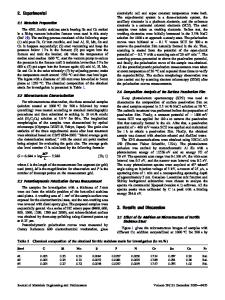Effect of anodic dissolution and passivation on X80 steel in NaHCO 3 solution
- PDF / 1,742,165 Bytes
- 10 Pages / 595.276 x 790.866 pts Page_size
- 0 Downloads / 278 Views
ORIGINAL PAPER
Effect of anodic dissolution and passivation on X80 steel in NaHCO3 solution Lai‑Shun Yang1,3 · Chao Yang2,3 Received: 28 February 2020 / Accepted: 14 September 2020 © The Author(s) 2020
Abstract The effects of extreme stray current on the anodic dissolution and passivation of X80 steel in N aHCO3 solution were investigated using measurements of polarization curves and EIS, AFM and SEM techniques. Under the interference of anodic current (i = 0~200 A/m2), main constituents of corrosion products of X80 steel were FeO(OH) and F e3O4. A double-layer 2 film formed at i = 100 A/m , in which FeOOH was in outer and Fe3O4 lied in inner. The formation mechanism of Fe3O4 was confirmed and described by the electrochemical reaction in various regions on anodic potentiodynamic polarization curve. Keywords Anodic current · Passivation · X80 steel · Fe3O4 · Near-neutral solution
1 Introduction In recent years, considerable attention has been paid to metal corrosion (Li et al. 2015). Buried pipelines have been spotlighted to be protected by combination of coatings (Cui et al. 2017; Prasai et al. 2012) and cathodic protection (Refait et al. 2015). Even though this method is widely considered to be sufficiently effective, stray current makes it impossible to pipeline away from corrosion, especially in which there are some defects on coatings. Numerous efforts (Chen et al. 2017; Jadhav and Gelling 2019) have been made to investigate the corrosion process of steel, as well as the corrosion products, and stray current is caught more attention due to its surprisingly critical corrosion rate. Compared to direct stray current (DC), more literature focuses on its corrosion rate, product, mechanism and model of alternating stray current (AC), and a comprehensive Edited by Xiu-Qiu Peng * Chao Yang [email protected] 1
College of Civil Engineering and Architecture, Shandong University of Science and Technology, Qingdao 266590, Shandong, China
2
Technology Inspection Center of Shengli Oilfield, SINOPEC, Dongying 257000, Shandong, China
3
China University of Petroleum (East China), Qingdao 266580, Shandong, China
understanding has been in consensus (Xu et al. 2012). However, based on the regulation that DC corrosion rate conforms to Faraday’s law, few researches have been conducted on its corrosion behavior, even though corrosion rate resulted by DC is much larger than that of AC. Furthermore, corrosion becomes more severely with the development of HVDC (High Voltage Direct Current), which current flowing into soil can reach thousands of amperes once this system runs in fault (Nicholson 2010). The results we got preliminary based on simulation and field test show the peak of current density at defects on coatings can reach 150 A/ m2, which may cause the rapid perforation of pipeline (Yang et al. 2019). It is interesting that at some points current flows out into soil, the surface of defects is covered with a layer of dense products, which prevents the later soil corrosion. However, this issue has no
Data Loading...











